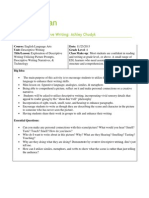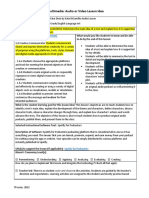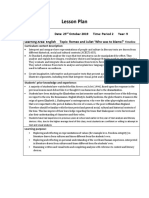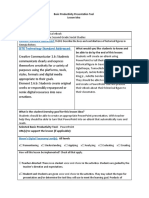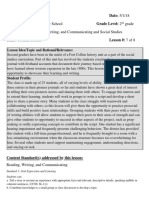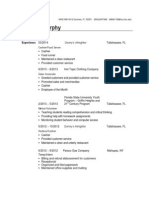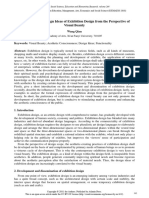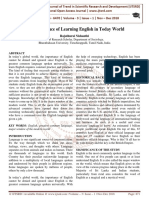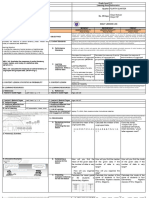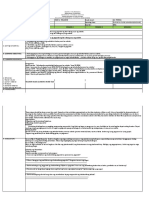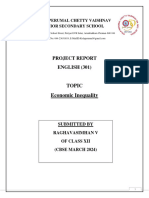Professional Documents
Culture Documents
Murphy - Integration LP
Murphy - Integration LP
Uploaded by
api-242642664Original Description:
Original Title
Copyright
Available Formats
Share this document
Did you find this document useful?
Is this content inappropriate?
Report this DocumentCopyright:
Available Formats
Murphy - Integration LP
Murphy - Integration LP
Uploaded by
api-242642664Copyright:
Available Formats
TECHNOLOGY INTEGRATION UNIT PLAN
FLORIDA STATE UNIVERSITY
LAE4867
TECHNOLOGY INTEGRATION UNIT PLAN
MYLE MURPHY
PURPOSE/RATIONALE:
TECHNOLOGY INTEGRATION UNIT PLAN
These lessons are intended for a tenth grade for a regular English class for 50
minutes during the second semester towards the end of the school year. These
lessons will integrate the technology site, StoryBird, in order to create, edit, and
share their narratives with their peers as well as critique and offer suggestions to
one another. The site, StoryBird, can be set to a classroom privacy setting that will
allow for parents and peers to view each students' works.
During this week of lessons students will be working on character
development and descriptive language while they manifest a narrative similar to
that of the novels read previously in the earlier weeks such novels as Catcher in
the Rye, Fault in Our Stars, and American Born Chinese. Students will develop
characters and background through well-developed, well-conceptualized, edited and
peer-reviewed lessons as well as working through the site, StoryBird.
COMMON CORE STANDARDS:
CCSS.ELA-LITERACY.W.9-10.4 Produce clear and coherent writing in which the
development, organization, and style are appropriate to task, purpose, and
audience. (Grade-specific expectations for writing types are defined in standards 13 above.)
CCSS.ELA-LITERACY.W.9-10.5 Develop and strengthen writing as needed by
planning, revising, editing, rewriting, or trying a new approach, focusing on
addressing what is most significant for a specific purpose and audience. (Editing for
conventions should demonstrate command of Language standards 1-3 up to and
including grades 9-10 here.)
CCSS.ELA-LITERACY.W.9-10.6 Use technology, including the Internet, to
produce, publish, and update individual or shared writing products, taking
advantage of technology's capacity to link to other information and to display
information flexibly and dynamically.
NCTE 21ST CENTURY LITERACY FRAMEWORK:
Students adjust their use of spoken, written, and visual language (e.g.,
conventions, style, vocabulary) to communicate effectively with a variety of
audiences and for different purposes.
Students employ a wide range of strategies as they write and use different
writing process elements appropriately to communicate with different
audiences for a variety of purposes.
Students apply knowledge of language structure, language conventions (e.g.,
spelling and punctuation), media techniques, figurative language, and genre
to create, critique, and discuss print and non-print texts.
TECHNOLOGY INTEGRATION UNIT PLAN
Students use a variety of technological and information resources (e.g.,
libraries, databases, computer networks, video) to gather and synthesize
information and to create and communicate knowledge.
Students develop an understanding of and respect for diversity in language
use, patterns, and dialects across cultures, ethnic groups, geographic regions,
and social roles
ISTE STANDARDS:
1. Creativity and innovation : Students demonstrate creative thinking, construct
knowledge, and develop innovative products and processes using
technology.
2. Communication and collaboration: Students use digital media and
environments to communicate and work collaboratively, including at a
distance, to support individual learning and contribute to the learning of
others.
3. Technology operations and concepts: Students demonstrate a sound
understanding of technology concepts, systems, and operations.
OBJECTIVES:
STUDENTS WILL BE ABLE TO:
Manifest and well-develop characters and plot line
Create a well-developed narrative using technology
Editing and peer-reviewing using concepts learned
MATERIALS:
Pen, Paper, Pencil
Coloring tools
Laptop cart
Image scanner
StoryBird site
Organization charts
UNIT ACCOMMODATIONS
TECHNOLOGY INTEGRATION UNIT PLAN
Teacher will provide full explanations and answer any questions or confusions
that students have with the material through clear and elaborated instruction.
Teacher will answer and assist with any help needed. Students that need further
assistance alongside their IEP forms will be provided accommodations that include
enlarged print, personal copies of directions (as well as roughly translated versions
in their L1 in the case that the ELL may need more help in the English language),
provided examples and teacher assistance.
Students that are physically impaired will not be asked to move around
unless it is more beneficial for said student to sit in a particular spot (front of
classroom, by teacher, near exit, etc.). Students that are behind reading level or
may be retread will not be isolated or left out because all students will be given the
same tools and resources as well as further side assistance by teacher. Further
resources may be brought into class by teacher if it is obvious that students in this
category or in overall are struggling. Students with ADHD may need to move around
the classroom to exert extra energy, this will be allowed as long as it is not
disruptive and students demonstrate that they are indeed working on tasks.
DAY 1 Develop Character Background
ANTICIPATORY SET:
(5-10 minutes) Teacher will introduce the subject of character development
through samples of characters by presenting students with images of popular and
well-known characters. Students will briefly discuss what traits the characters have
that make them distinctive and interesting.
TICK/TOCK:
TIME
10-12
minute
s
TEACHER WILL
Teacher will present
images of characters that
are less known. Teacher will
watch and keep students on
task for brief task.
15-20
minute
s
Teacher will present
lecture
lesson
through
PowerPoint of what it takes
and what tools to use to
create
multidimensional
characters.
Teacher will explain the
concept of the character
project that the students will
participating in.
5-10
minute
s
STUDENT WILL
Students will write descriptions that give
the images a background and an
explanation for why the images look the
way that they do. Students will briefly
discuss their writings with a peer to their
left or right.
Students will watch, create notes, and
ask questions on character development
PowerPoints. Students will be asked to
create quick examples of traits during the
lesson to insure that students are
understanding the concepts.
Students will listen to the teacher.
Students will begin brainstorming the
possible character(s) that they may want to
include in an overall narrative project and
TECHNOLOGY INTEGRATION UNIT PLAN
Teacher will discuss how the tools that they learned today in order
this upcoming week of to create well-developed characters.
lessons will eventually lead
into a project of creating
narratives
that
will
be
published onto the site,
Storybird.
CLOSURE:
(5 minutes) Teacher will answer any questions and explain that the use of
laptops will be available everyday in order for students to become familiar with
StoryBird and work on developing their characters as well as their characters'
images.
Homework:
Students will review the PowerPoint through the Flipped Classroom section of
the class website. Students will begin to work on their characters and what their
characters' backgrounds may be like.
SPECIFIC ACCOMMODATIONS:
Students that need any assistance other than that has been provided by the
student's IEP will be provided with that extra assistance. Students that do not have
access to the internet to review the PowerPoint Flipped Classroom may come before
or after school or during their lunch period to review the concepts of character
development.
DAY 2 : Introduction to StoryBird - Pictures
ANTICIPATORY SET:
( 5-10 minutes) Teacher will review the lesson from the day before with a brief
showing of what a well-developed character is consistent of and how background
plays into this character's personality. Teacher will also review how characters affect
storyline and that the ultimate narrative project that this current project will lead
into needs to be well-developed through characters.
TICK/TOCK:
TIME
10
minute
s
TEACHER WILL
Teacher will introduce the
concept
of
StoryBird
by
bringing the website up on the
smart board.
The teacher will work through
the different aspects, like
STUDENT WILL
Students will view the many possibilities
of what the site can provide and take
notes on aspects that they may be
interested in for their projects.
TECHNOLOGY INTEGRATION UNIT PLAN
10-15
minute
s
photo usage, peer-review and
publishing. The teacher will
emphasis the use of pictures
to help portray story telling.
Teacher will introduce project
idea
of
character
and
character
background
to
students that will eventually
lead to a narrative project.
Students will begin mapping out the
characters that they are interested in
having partake within their narratives.
This will allow students a chance to begin
thinking about what their plot line may
become based on what types of
Teacher will assist in helping characters live in the world.
students find images that work
Students will write out what their
for
their
characters
and characters will be like physically,
features that will further their personality-wise,
limitations,
character's
personalities, backgrounds and input into plot line.
background
and
possible Students will search on StoryBird, online,
storyline
or create the image of their characters.
Students will dedicate this time to create
the characters that will be uploaded,
scanned or pasted into the texts.
Students will describe what each aspect
of the character is and why the character
is given this trait.
CLOSURE:
(5-10 minutes) Teacher will wrap the end of the class period by discussing
what the teacher saw explaining any issues that the teacher saw throughout the
class period.
HOMEWORK:
Students will write thorough descriptions of the characters that they created
during class and what the characters' roles will be within future narratives.
Students will brainstorm the character's personality and background for the
following lesson.
Students can look at the flipped classroom Character development that is
featured on the class website to better help with choosing character images and
descriptions. Students should also be looking at the Descriptive Language Flipped
Classroom
SPECIFIC ACCOMMODATIONS:
Students that are not artistically inclined can choose to upload photos from
online or use the images from the site, StoryBird. Students that have physical
limitations that require further assistance than that mentioned in their IEPs will be
TECHNOLOGY INTEGRATION UNIT PLAN
provided help through the teacher, extra tools (like a screen cover), and/or an
assistant.
DAY 3: Description - Peer-review/workshop
ANTICIPATORY SET:
(5 minutes) Teacher will review the activities of the previous day and how
character development transformed through the character's physical description
and the character's background.
TICK/TOCK:
TIME
10-12
minute
s
5-8
minute
s
15-20
minute
s
TEACHER WILL
Teacher
will
present
the
Descriptive Language PowerPoint
in order to help students better
describe their characters and
background.
The teacher will provide images for
students to begin describing as
well as ask students to create vivid
descriptions of images that the
students have thought of on their
own.
Teacher will assist students with
entering the website as well as
assisting students in greater and
more in depth descriptions for their
characters.
Teacher will, also, keep students on
task with their writings and using
the laptops appropriately.
STUDENT WILL
Students will take notes and discuss
what they understand from the
PowerPoint.
Students
will
ask
questions when they are confused or
need further explanation.
Students will practice describing
scenes, people, and objects using
the
language
taught
in
the
PowerPoint quietly in their journals.
Students will begin writing their
descriptions that they have created
for their characters into their
StoryBirds as well as editing their
descriptions with language that was
seen in the PowerPoint.
Students will print out their
descriptions from the site to take
home to edit manually (with
handwriting, highlighting, etc.).
CLOSURE:
(5-7 minutes) Teacher will discuss the descriptions that were overused in the
majority of students' works and how they may consider to change those similar
issues. Students will be handed their printouts and will ask teacher any remaining
questions for the day.
HOMEWORK:
Students will take their print-outs home and begin their personal editing in
order to change poor descriptions for better descriptions and revise any ideas that
TECHNOLOGY INTEGRATION UNIT PLAN
need tweaking. Students will and can review the Flipped Classroom lesson plans
(descriptive language and character development) as well as review their class
notes in order to improve their writing and the publication that will be placed onto
StoryBird.
SPECIFIC ACCOMMODATIONS:
Students that need any assistance other than that has been provided by the
student's IEP will be provided with that extra assistance. Students may personally
speak with the teacher and/or email the teacher for any further questions. Students
are, also, able to come into class before or after school as well as come in during
their lunch period.
DAY 4: Peer-review/Workshop day
ANTICIPATORY SET:
(5-10 minutes) Teacher will review the previous lesson including a review of
what character development tools are, descriptive language (from the Flipped
Classroom) and how StoryBird will be involved in the writing process. Teacher will
answer any questions about the work that has been done and will explain that
today's lesson will focus on peer-review of the characters that have been created so
far and what their roles may lead to.
TICK/TOCK:
TIME
5-8
minute
s
15-20
minute
s
5-10
minute
s
TEACHER WILL
Teacher will briefly go
through how students can
upload images and how
students can enter their
writings on the site.
Teacher will watch and
monitor students on staying
on task.
Teacher will assist students
on entering the site and
working on their images.
Teacher will assist
students on how to review
the work of the class and
how to provide constructive
feedback.
The teacher will assist
students
on
what
characters
should
be
STUDENT WILL
Students are encouraged to take notes
(steps) on how to enter the site, upload
images, and begin their writing.
Students will begin writing their
character(s) into their StoryBird account as
well as uploading (scanning) their images
that they plan to use for their characters.
Students will write a brief explanation of
the character and why their character looks
how it does.
Students will begin to review their peers'
characters and backgrounds providing
constructive feedback and provide input on
what aspects the characters may be
missing. Students will review at least four
characters every classmate must be
reviewed and provide some input other
than penny worth statements.
TECHNOLOGY INTEGRATION UNIT PLAN
consisting of and question *penny statements are statements that are
what the readers think the shallow and provide no feedback , like great
storyline will become based job! Nice! And Kudos! To name a few.
on these descriptions.
CLOSURE:
(5-10 minutes) Students will review the feedback that they have been
presented by their peers and brainstorm on what can be added in order to better
their descriptions and concepts. Teacher will be available for any questions or
suggestions about the first entries onto StoryBird.
SPECIFIC ACCOMMODATIONS:
Students that have physical limitations that require further assistance than
that mentioned in their IEPs will be provided help through the teacher, extra tools
(like a screen cover), and/or an assistant. Students that need any assistance other
than that has been provided by the student's IEP will be provided with that extra
assistance. Students may personally speak with the teacher and/or email the
teacher for any further questions. Students are, also, able to come into class before
or after school as well as come in during their lunch period.
DAY 5 Publication onto Storybird
ANTICIPATORY SET:
(5-minutes) The teacher will review the previous lessons that have been
presented throughout the week. The teacher will discuss how this lesson will be the
last day to dedicate in class time on character development.
TICK/TOCK:
TIME
10
minute
s
30-35
minute
s
TEACHER WILL
Teacher will review and assist
students on last minute reviews for
their submissions.
STUDENT WILL
Students will have their last peer
review with a close-seated classmate
or ask the teacher for a personal
review. Students will take reviews
into consideration and begin their
last minute changes.
Teacher will answer any questions Students will work on rewriting their
and assist students with the descriptions of their characters after
website as well as provide their peer-review and teacher's
suggestions on last minute tweaks. suggestions.
Students will upload their images
and image descriptions (with their
revised descriptions) and create their
final submission for StoryBird.
TECHNOLOGY INTEGRATION UNIT PLAN
10
CLOSURE:
(5 minutes) The teacher will end the lesson by assisting students in their
submissions and discussing the importance of characters that are well-developed
and well described. These characters will guide and greatly influence the narrative's
plot line.
HOMEWORK:
N/A
SPECIFIC ACCOMMODATIONS:
Students that have physical limitations that require further assistance than
that mentioned in their IEPs will be provided help through the teacher, extra tools
(like a screen cover), and/or an assistant. Students that need any assistance other
than that has been provided by the student's IEP will be provided with that extra
assistance. Students may personally speak with the teacher and/or email the
teacher for any further questions. Students are, also, able to come into class before
or after school as well as come in during their lunch period.
REFERENCES:
STORYBIRD accessed on July 28, 2014 at Storybird.com
GOOGLE IMAGES accessed on July 28, 2014 at Google.com/images
APPENDICES:
DESCRIPE THESE CHARACTERS:
TECHNOLOGY INTEGRATION UNIT PLAN
POWERPOINTS
CHARACTER DEVELOPMENT
11
TECHNOLOGY INTEGRATION UNIT PLAN
DESCRIPTIVE LANGUAGE
Storybird
12
You might also like
- Siop Lesson PlanDocument5 pagesSiop Lesson Planapi-388967335No ratings yet
- Krantzberg Lianna Ped3141 A Lessonplanversion2 0-2Document6 pagesKrantzberg Lianna Ped3141 A Lessonplanversion2 0-2api-298637272No ratings yet
- Puns Lesson Plan Day 2Document7 pagesPuns Lesson Plan Day 2api-395010751No ratings yet
- Thematic Literature ReviewDocument36 pagesThematic Literature ReviewIam SheynNo ratings yet
- Differentiated Learning With Seesaw HandoutDocument7 pagesDifferentiated Learning With Seesaw Handoutapi-468171582No ratings yet
- Educ6038 Assignment 3for WebsiteDocument6 pagesEduc6038 Assignment 3for Websiteapi-237701704No ratings yet
- Millicent Atkins School of Education: Common Lesson Plan TemplateDocument7 pagesMillicent Atkins School of Education: Common Lesson Plan Templateapi-533575661No ratings yet
- Expository Text: Grade 5Document4 pagesExpository Text: Grade 5api-337420634No ratings yet
- Edtpa Lesson Plan Guide LPG - 1 1Document6 pagesEdtpa Lesson Plan Guide LPG - 1 1api-698813897No ratings yet
- Lesson Plan New OneDocument6 pagesLesson Plan New Oneapi-238094911No ratings yet
- 21st Century Instructional Plan Student PopulationDocument9 pages21st Century Instructional Plan Student PopulationAlexander MartinNo ratings yet
- Second Grade Ela Lesson Plan PodcastDocument3 pagesSecond Grade Ela Lesson Plan Podcastapi-677466231No ratings yet
- Multimedia Audio or Video Lesson Idea - Breann HightowerDocument3 pagesMultimedia Audio or Video Lesson Idea - Breann Hightowerapi-675360562No ratings yet
- 9 Lesson 5Document6 pages9 Lesson 5api-372464959No ratings yet
- Lesson Plan Teachers Names: Jessica, Sam, Ruby Date: April 28, 2016 Grade Level: 8 MD Common Core StandardDocument6 pagesLesson Plan Teachers Names: Jessica, Sam, Ruby Date: April 28, 2016 Grade Level: 8 MD Common Core Standardapi-317474684No ratings yet
- Technology Integration UnitDocument8 pagesTechnology Integration Unitapi-242273696No ratings yet
- Running Head: ABOUT FACES 1: About Faces A Look at Technology in The Art ClassroomDocument11 pagesRunning Head: ABOUT FACES 1: About Faces A Look at Technology in The Art Classroomapi-393898184No ratings yet
- Instructional Software Lesson PlanDocument4 pagesInstructional Software Lesson Planapi-554061413No ratings yet
- Tep Lesson Plan Informal 1Document3 pagesTep Lesson Plan Informal 1api-740567085No ratings yet
- Lesson Plan For Implementing NETS - S-Template I: (More Directed Learning Activities)Document7 pagesLesson Plan For Implementing NETS - S-Template I: (More Directed Learning Activities)api-405559723No ratings yet
- When The Faulkner Am IDocument11 pagesWhen The Faulkner Am Iapi-260269748No ratings yet
- Team TeachingDocument8 pagesTeam Teachingapi-316017955No ratings yet
- Guión Gráfico (Storyboard) : Common Core StandardsDocument5 pagesGuión Gráfico (Storyboard) : Common Core StandardsLouise EberleNo ratings yet
- BPT LessonDocument3 pagesBPT Lessonapi-723401996No ratings yet
- Lesson Plan For Implementing NETS - S-Template I: (More Directed Learning Activities)Document6 pagesLesson Plan For Implementing NETS - S-Template I: (More Directed Learning Activities)api-438168651No ratings yet
- Lae 4863 Technology Integration UnitDocument12 pagesLae 4863 Technology Integration Unitapi-242598382No ratings yet
- EDUC 2220-Educational Technology Lesson Plan Biographies: Common Core StandardsDocument6 pagesEDUC 2220-Educational Technology Lesson Plan Biographies: Common Core Standardshope beverickNo ratings yet
- Slms Lesson PlanDocument7 pagesSlms Lesson Planapi-270690966No ratings yet
- Lesson Plan Template: NEPF + Components of An Effective Lesson HybridDocument4 pagesLesson Plan Template: NEPF + Components of An Effective Lesson Hybridapi-286066914No ratings yet
- Imovie Lesson PlanDocument3 pagesImovie Lesson Planapi-271785322No ratings yet
- Sarah King Lesson Plan R2Document4 pagesSarah King Lesson Plan R2Sarah KingNo ratings yet
- Second Grade Social Stuides Georigia Historcal Figures EbookDocument3 pagesSecond Grade Social Stuides Georigia Historcal Figures Ebookapi-677466231No ratings yet
- 480 - Final BriefDocument8 pages480 - Final Briefjlc5261No ratings yet
- Esi Project - ConsentDocument11 pagesEsi Project - ConsentBar ONo ratings yet
- Standard ESL Lesson Plan Format: Attachment F Fordham University Graduate School of Education Tesol ProgramDocument6 pagesStandard ESL Lesson Plan Format: Attachment F Fordham University Graduate School of Education Tesol ProgramKaran Lee100% (2)
- Technology Integration Unit Launch Page: Type Only in The Gray AreasDocument5 pagesTechnology Integration Unit Launch Page: Type Only in The Gray AreasjmwernerNo ratings yet
- Text Based Sculptures 3Document17 pagesText Based Sculptures 3api-250073958No ratings yet
- Millicent Atkins School of Education: Common Lesson Plan TemplateDocument4 pagesMillicent Atkins School of Education: Common Lesson Plan Templateapi-529954029No ratings yet
- Curriculum ProposalDocument8 pagesCurriculum ProposalJhon Alexander Estrada HincapiéNo ratings yet
- Text Based Sculptures 1Document15 pagesText Based Sculptures 1api-250073958No ratings yet
- Lesson Plan For Implementing NETS - S-Template I: (More Directed Learning Activities)Document13 pagesLesson Plan For Implementing NETS - S-Template I: (More Directed Learning Activities)api-509818611No ratings yet
- Pioneer LessonDocument8 pagesPioneer Lessonapi-340407741No ratings yet
- 3rd Grade On The Set LessonDocument2 pages3rd Grade On The Set Lessonapi-240328219No ratings yet
- Episode 1 Chapter 3 Page 100 Episode TwoDocument8 pagesEpisode 1 Chapter 3 Page 100 Episode Twoapi-290342899No ratings yet
- EDUC 2220-Educational Technology Lesson Plan Personal Experience Narratives Alexa Jackson Second Grade English Language Arts - WritingDocument12 pagesEDUC 2220-Educational Technology Lesson Plan Personal Experience Narratives Alexa Jackson Second Grade English Language Arts - WritingAlexa JacksonNo ratings yet
- Unit OverviewDocument3 pagesUnit Overviewapi-263677727No ratings yet
- Danielson Aligned Lesson Plan Template For Formal ObservationsDocument10 pagesDanielson Aligned Lesson Plan Template For Formal Observationsapi-272846979No ratings yet
- Edu 4010-Unit Plan Lesson Plan 1Document2 pagesEdu 4010-Unit Plan Lesson Plan 1api-272636037No ratings yet
- Text Structure Unit PlanDocument8 pagesText Structure Unit Planapi-550169285No ratings yet
- EDUC2220LessonPlan-Emily WelshDocument7 pagesEDUC2220LessonPlan-Emily WelshEmily WelshNo ratings yet
- Caption It!: Common Core StandardsDocument6 pagesCaption It!: Common Core Standardsalenhart2No ratings yet
- 320 Psych LP - OrganizersDocument8 pages320 Psych LP - Organizersapi-310123009No ratings yet
- Puns Lesson Plan Day 1Document9 pagesPuns Lesson Plan Day 1api-395010751No ratings yet
- Constructivist UnitDocument7 pagesConstructivist Unitapi-358655610No ratings yet
- Lesson Plan 2Document4 pagesLesson Plan 2api-252771265No ratings yet
- Multimedia Design Project Assessment (MDPA) Report Template: Product URL: AnalysisDocument7 pagesMultimedia Design Project Assessment (MDPA) Report Template: Product URL: Analysisapi-653434151No ratings yet
- Task 3-Backwards DesignDocument11 pagesTask 3-Backwards Designapi-335318523No ratings yet
- Of Mice and Men Day 1Document5 pagesOf Mice and Men Day 1api-252410382No ratings yet
- Multimedia Lesson IdeaDocument2 pagesMultimedia Lesson Ideamariesmile16No ratings yet
- ProductivitytoolsfixedDocument2 pagesProductivitytoolsfixedapi-370123158No ratings yet
- Media Enhanced Assure Lesson PlanDocument5 pagesMedia Enhanced Assure Lesson Planapi-324568340No ratings yet
- 21st Century Skills: A Pocket of Mobile Learning Tools for Language TeachersFrom Everand21st Century Skills: A Pocket of Mobile Learning Tools for Language TeachersRating: 2 out of 5 stars2/5 (1)
- Murphy Myle Lae3333 - Word Choice UnitDocument28 pagesMurphy Myle Lae3333 - Word Choice Unitapi-242642664No ratings yet
- Murphy - Linguistic LPDocument9 pagesMurphy - Linguistic LPapi-242642664No ratings yet
- TSL Mock Trial Lesson PlanDocument2 pagesTSL Mock Trial Lesson Planapi-242642664No ratings yet
- Lesson PlanDocument5 pagesLesson Planapi-242642664No ratings yet
- Myle Murphy - ResumeDocument2 pagesMyle Murphy - Resumeapi-242642664No ratings yet
- Murphy Myle Lae3333 - Word Choice UnitDocument28 pagesMurphy Myle Lae3333 - Word Choice Unitapi-242642664No ratings yet
- Murphy - Resume W References UpdatedDocument3 pagesMurphy - Resume W References Updatedapi-242642664No ratings yet
- Research On The Design Ideas of Exhibition Design From The Perspective of Visual BeautyDocument5 pagesResearch On The Design Ideas of Exhibition Design From The Perspective of Visual BeautynyeinayeeeNo ratings yet
- Handout 2Document4 pagesHandout 2MAAZNo ratings yet
- 928-Article Text-6809-2-10-20200124Document27 pages928-Article Text-6809-2-10-20200124Pawan DahalNo ratings yet
- Q4 Week4 DLL April 22 26Document9 pagesQ4 Week4 DLL April 22 26Mark SolivaNo ratings yet
- Field Study 1 SoftDocument315 pagesField Study 1 SoftZyrus John BenitezNo ratings yet
- Memo Preparation of WHLP Cum Contextualization - LocalizationDocument5 pagesMemo Preparation of WHLP Cum Contextualization - LocalizationDelaCruz Alburo DennisMarkNo ratings yet
- UNIT 4 - LESSON 3 - PART 1 - Listening and ReadingDocument5 pagesUNIT 4 - LESSON 3 - PART 1 - Listening and ReadingPhuongNo ratings yet
- Tet WBSSCDocument3 pagesTet WBSSCCHHOTO SEHARA HIGH SCHOOLNo ratings yet
- Final Research Paper PDFDocument12 pagesFinal Research Paper PDFKely FernandesNo ratings yet
- Lac Session Reflection 8Document2 pagesLac Session Reflection 8Aiza AbantoNo ratings yet
- PRAKTICUM Observation Lesson PlanDocument3 pagesPRAKTICUM Observation Lesson PlanESWARY A/P VASUDEVAN MoeNo ratings yet
- DLP in Pe 10 Cheerdance 3 Final PracticumDocument4 pagesDLP in Pe 10 Cheerdance 3 Final PracticumChristopherArjayCigaral50% (2)
- Educational Facilities and Vocational ActivitiesDocument5 pagesEducational Facilities and Vocational ActivitiesNeeraj KumarNo ratings yet
- Brooktree Community Newsletter 01.11.2023Document3 pagesBrooktree Community Newsletter 01.11.2023gayathriNo ratings yet
- Field Experience Assignment #2Document2 pagesField Experience Assignment #2Natali OrtizNo ratings yet
- DR - Srikala BharathDocument61 pagesDR - Srikala BharathBappaditya ChowdhuryNo ratings yet
- Action Plan Fani 2020-2021Document3 pagesAction Plan Fani 2020-2021Funny FiadcongNo ratings yet
- Junior HS: List of Teachers With Special AssignmentDocument3 pagesJunior HS: List of Teachers With Special AssignmentJerick SubadNo ratings yet
- FS1. Learning Ep. 01. The School EnvironmentDocument13 pagesFS1. Learning Ep. 01. The School EnvironmentJohn Dave MabántaNo ratings yet
- I. Objectives: The Learners Have An Understanding of Poetry As A Genre and How To Analyze Its Elements and TechniquesDocument4 pagesI. Objectives: The Learners Have An Understanding of Poetry As A Genre and How To Analyze Its Elements and TechniquesMary DignosNo ratings yet
- EDITED Lesson Plan Template SY2022 2023Document12 pagesEDITED Lesson Plan Template SY2022 2023Elsie Alcover RelacionNo ratings yet
- Plus Factor: Objective 13 MOV'sDocument14 pagesPlus Factor: Objective 13 MOV'sJeffrey Vallente50% (2)
- Academic Program Reduction Elimination ProcessDocument9 pagesAcademic Program Reduction Elimination ProcessOscar Garcia AltagraciaNo ratings yet
- BED 216 DST English PDFDocument84 pagesBED 216 DST English PDFRajat GautamNo ratings yet
- English Project Raghavasimhan V XII-B - v1.2Document22 pagesEnglish Project Raghavasimhan V XII-B - v1.2VIVAAS .SNo ratings yet
- Ateneo de Davao University Social Sciences Cluster Weekly Training Activities ReportDocument9 pagesAteneo de Davao University Social Sciences Cluster Weekly Training Activities ReportluismisaNo ratings yet
- Reading FluencyDocument2 pagesReading FluencyTiffany Galloway100% (1)
- My ResumeDocument2 pagesMy Resumeapi-279813564No ratings yet









